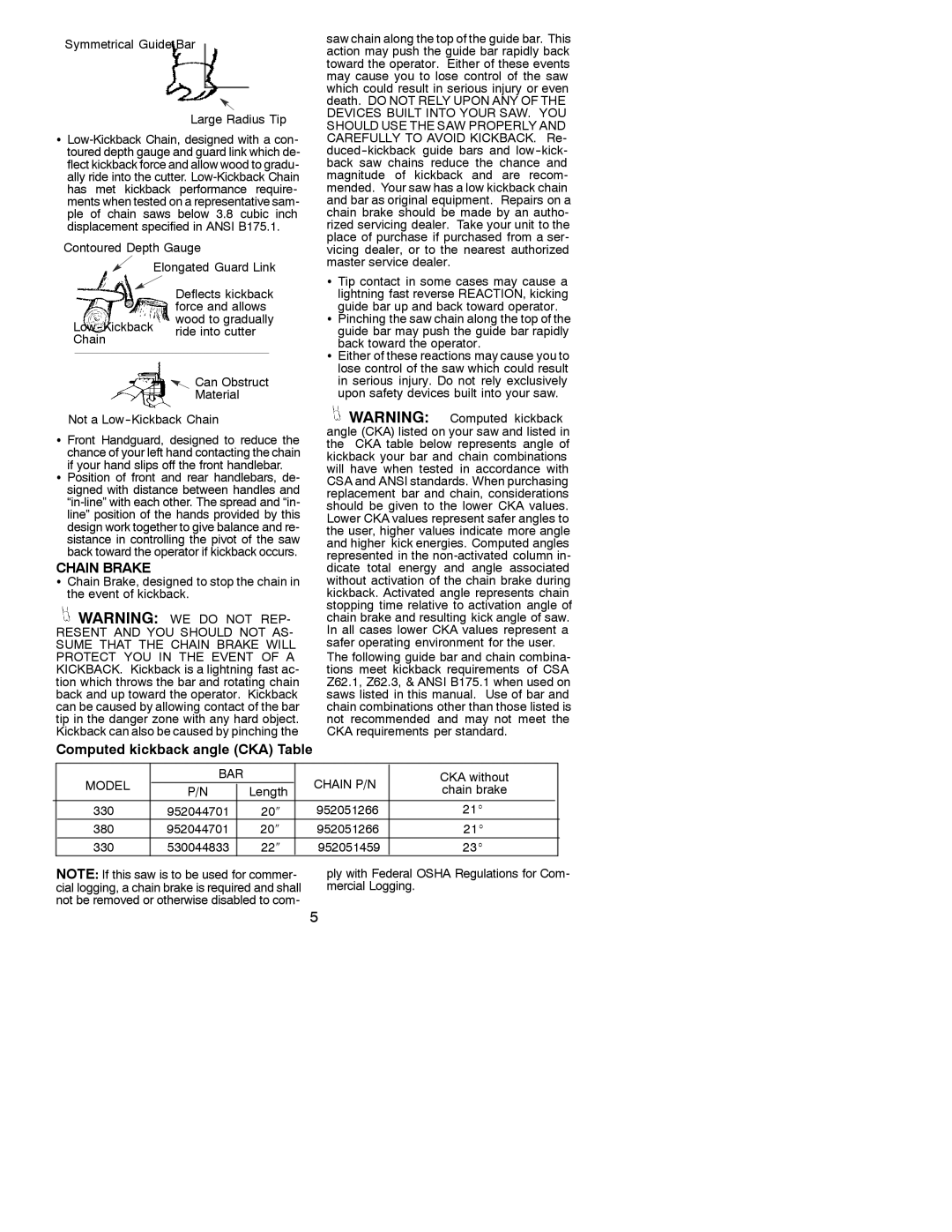
Symmetrical Guide Bar
Large Radius Tip
S
Contoured Depth Gauge ![]() Elongated Guard Link
Elongated Guard Link
Deflects kickback force and allows
wood to gradually
Can Obstruct
Material
Not a
S Front Handguard, designed to reduce the chance of your left hand contacting the chain if your hand slips off the front handlebar.
S Position of front and rear handlebars, de- signed with distance between handles and
CHAIN BRAKE
SChain Brake, designed to stop the chain in the event of kickback.
![]() WARNING: WE DO NOT REP- RESENT AND YOU SHOULD NOT AS- SUME THAT THE CHAIN BRAKE WILL PROTECT YOU IN THE EVENT OF A KICKBACK. Kickback is a lightning fast ac- tion which throws the bar and rotating chain back and up toward the operator. Kickback can be caused by allowing contact of the bar tip in the danger zone with any hard object. Kickback can also be caused by pinching the
WARNING: WE DO NOT REP- RESENT AND YOU SHOULD NOT AS- SUME THAT THE CHAIN BRAKE WILL PROTECT YOU IN THE EVENT OF A KICKBACK. Kickback is a lightning fast ac- tion which throws the bar and rotating chain back and up toward the operator. Kickback can be caused by allowing contact of the bar tip in the danger zone with any hard object. Kickback can also be caused by pinching the
saw chain along the top of the guide bar. This action may push the guide bar rapidly back toward the operator. Either of these events may cause you to lose control of the saw which could result in serious injury or even death. DO NOT RELY UPON ANY OF THE DEVICES BUILT INTO YOUR SAW. YOU SHOULD USE THE SAW PROPERLY AND CAREFULLY TO AVOID KICKBACK. Re-
S Tip contact in some cases may cause a lightning fast reverse REACTION, kicking guide bar up and back toward operator.
SPinching the saw chain along the top of the
guide bar may push the guide bar rapidly back toward the operator.
SEither of these reactions may cause you to lose control of the saw which could result in serious injury. Do not rely exclusively upon safety devices built into your saw.
![]() WARNING: Computed kickback angle (CKA) listed on your saw and listed in the CKA table below represents angle of kickback your bar and chain combinations will have when tested in accordance with CSA and ANSI standards. When purchasing replacement bar and chain, considerations should be given to the lower CKA values. Lower CKA values represent safer angles to the user, higher values indicate more angle and higher kick energies. Computed angles represented in the
WARNING: Computed kickback angle (CKA) listed on your saw and listed in the CKA table below represents angle of kickback your bar and chain combinations will have when tested in accordance with CSA and ANSI standards. When purchasing replacement bar and chain, considerations should be given to the lower CKA values. Lower CKA values represent safer angles to the user, higher values indicate more angle and higher kick energies. Computed angles represented in the
Computed kickback angle (CKA) Table
| MODEL | BAR |
| CHAIN P/N | CKA without | ||
| P/N |
| Length | chain brake | |||
|
|
|
| ||||
| 330 | 952044701 |
| 20! | 952051266 | 21_ |
|
| 380 | 952044701 |
| 20! | 952051266 | 21_ |
|
| 330 | 530044833 |
| 22! | 952051459 | 23_ |
|
NOTE: If this saw is to be used for commer- cial logging, a chain brake is required and shall not be removed or otherwise disabled to com-
ply with Federal OSHA Regulations for Com- mercial Logging.
5
